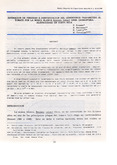| dc.contributor.author | Rosset, P. | |
| dc.contributor.author | Meneses R. | |
| dc.contributor.author | Lastra, R. | |
| dc.contributor.author | González, W. | |
| dc.date.accessioned | 2015-03-19T21:29:13Z | |
| dc.date.available | 2015-03-19T21:29:13Z | |
| dc.date.issued | 1990-03 | |
| dc.identifier.issn | e-ISSN: 1016-0469 | es_ES |
| dc.identifier.uri | https://repositorio.catie.ac.cr/handle/11554/6235 | |
| dc.description | 8 ilus. 13 ref. 11 pág. | es_ES |
| dc.description.abstract | En este estudio se analizaron datos experimentales provientes de Alajuela, Costa Rica, con el fin de examinar la relación entre la densidad poblacional de la mosca blanca y el rendimiento del tomate. Se encontró una relación cuadrática entre el número de adultos de la mosca blanca en la tercera hoja compuesta más joven de la planta a los 10 DDT y el porcentaje de frutos de un tamaño inferior a lo aceptable para el comercio (y = 40.2-11.1x +4.1x2 r2=0.97m P=0.03). La relación se puede representar linealmente mediante una regresión de punto de quiebra (y = 19.25x - 14.1 r2 = 0.98). También se reporta el primer hallazgo de partículas de un geminivirus en tomate de Centroamérica, confirmando así la presencia del tipo de virus cuyo vector es la mosca blanca. | es_ES |
| dc.description.abstract | In the present study we used experimental data to estimate yield loss due to whitefly infestation in irrigated pole tomato production. Infestastation by adult whiteflies was monitored weekly on the third apical compound leaf of the tomato plant. A significant cuadratic relationship was found between the number of adults on the third leaf at 10 days and the percentage of total fruits that were of a size too small for marketing (y = 40.2-11.1x +4.1x2 r2=0.97m P=0.03). The same relationship could be adequately represent by linear break-point regression as (y = 19.25x - 14.1 r2 = 0.98). We also present an electron micrograph representing the first confirmed finding of Geminivirus in tomato tissue from Central America. Geminiviruses are generally by whiteflies. | |
| dc.language.iso | es | es_Es |
| dc.publisher | CATIE, Turrialba (Costa Rica) | es_ES |
| dc.relation.ispartof | Manejo Integrado de Plagas y Agroecología Número 15 (Marzo 1990), páginas 24-34 | |
| dc.rights | info:eu-repo/semantics/openAccess | |
| dc.subject | BEMISIA TABACI | |
| dc.subject | GEMINIVIRUS | |
| dc.subject | GEMINIVIRUS RIZADO AMARILLO DEL TOMATE | |
| dc.subject | PLAGAS DE PLANTAS | |
| dc.subject | DENSIDAD DE LA POBLACION | |
| dc.subject | AGRICULTURA DE REGADIO | |
| dc.subject | RENDIMIENTO DE CULTIVOS | |
| dc.subject | EXPERIMENTACION EN CAMPO | |
| dc.subject | COSTA RICA | |
| dc.subject | LYCOPERSICON ESCULENTUM | es_ES |
| dc.title | Estimación de pérdidas e identificación del geminivirus transmitido al tomate por la mosca blanca Bemisia tabaci Genn. (Homoptera: Aleyrodidae) en Costa Rica | es_ES |
| dc.type | Artículo | es_ES |
| dc.journal.issueNumber | 15 | |


